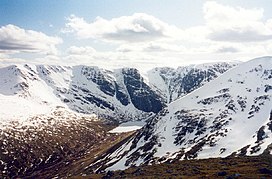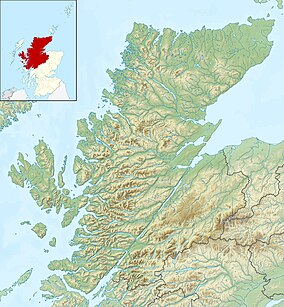Creag Meagaidh
| Creag Mèagaidh | |
|---|---|
 Coire Ardair and Creag Meagaidh | |
| Highest point | |
| Elevation | 1,130 m (3,710 ft)[1] |
| Prominence | 867 m (2,844 ft) Ranked 18thinBritish Isles |
| Parent peak | Ben Nevis |
| Listing | Marilyn,Munro |
| Naming | |
| Language of name | Gaelic |
| Pronunciation | Scottish Gaelic:[ˈkʰɾʲekˈmekɪ] |
| Geography | |
 | |
| Location | Glen Spean,Scotland |
| Parent range | Grampian Mountains |
| OS grid | NN418875 |
| Topo map | OSLandranger34, 42 |
| Name | Grid ref | Height | Status |
|---|---|---|---|
| Càrn Liath | NN472903 | 1,006 metres (3,301 ft) | Munro |
| Stob Poite Coire Ardair | NN428888 | 1,054 metres (3,458 ft) | Munro |
Creag Meagaidh(Scottish Gaelic:Creag Mèagaidh)[2]is a mountain on the northern side ofGlen Speanin theHighlandsofScotland.It is a complex mountain, made up of a flat summitplateau,with five ridges spreading out from it, overlooking five deepcorries;it is most famed for thecliffssurrounding the corrie ofCoire Ardairon the north-eastern face.[3]These crags are a renowned venue forice climbing.Creag Meagaidh rises to 1,130 metres (3,710 ft).
The neighbouring peaks ofStob Poite Coire ArdairandCàrn Liathare sometimes called theCreag Meagaidh range.The Creag Meagaidh massif is part of Creag MeagaidhNational Nature Reserve.The reserve covers 3,940 hectares, extending from the shores ofLoch Lagganto the high summit plateau of Creag Meagaidh. The reserve was designated in 1986 and is owned and managed byNatureScot.Creag Meagaidh is also designated as aSpecial Protection Area,and the number of grazing animals is controlled. This has led to a regrowth of the native woodland ofbirch,alder,willow,rowanandoak.The site is also an important breeding ground for many species ofbirds,in particular thedotterel.
Climbing
[edit]All three peaks in the range may be climbed fromAberarderon theA86 roadby initially following the path leading up Coire Ardair, before striking north to the summit of Càrn Liath. A circuit of the glen may be made by returning to Aberarder by way of Creag Meagaidh's east ridge. The most direct route to the summit of Creag Meagaidh ascends from the head of the corrie to reach a narrow gap between the crags known asThe Window.The Window forms thebealachbetween Creag Meagaidh and Stob Poite Coire Ardair. Creag Meagaidh may also be climbed fromMoyto the southeast.[3]
These crags are a renowned venue for winter andice climbing,although being somewhat vegetated they are less suited tosummer climbing.[4]
In 2016 a person died in an avalanche on Creag Meagaidh and a second person was taken to hospital in a serious condition. [5]
Nature and conservation
[edit]Flora and fauna
[edit]| Creag Meagaidh National Nature Reserve | |
|---|---|
IUCN categoryIV (habitat/species management area)[6] | |
 An information board at Creag Meagaidh National Nature Reserve | |
| Location | Highland,Scotland |
| Coordinates | 56°57′06″N4°36′10″W/ 56.95162°N 4.60274°W |
| Area | 39.5 km2(15.3 sq mi)[7] |
| Established | 1986[6] |
| Governing body | NatureScot |
| Creag Meagaidh National Nature Reserve | |
A number of nationally important plant species can be found at Creag Meagaidh, includingwoolly willow,wavymeadow grass,highland saxifrage,bog orchidandScots pine.Over 120 species of lichen have also been recorded.[8][9]The summit of the massif is carpeted in moss heath andstiff sedge,being one of the largest areas ofwoolly fringemossheath in the UK.[8]The cliffs above Coire Ardair have mostly avoided grazing and support a number of rare species such asalpine foxtail,alpine lady-fern,Norwegian cudweed,downy willowandsibbaldia.[10]
Over 150 species of invertebrates have been recorded on the summit plateau. This number include rarities such as thelarge wolf spider,which within Scotland is found only on one or two of the highest summits. One species of fly that has been identified at Creag Meagaidh,Spilogona trigonata,is not found anywhere else in Britain, being generally restricted to Scandinavia and North America.[11]
According to NatureScot, 137 different bird species have been recorded within the Reserve.[9]Of these, one particular species of note is thedotterel,which is one of Britain's rarest birds: the upper part of the mountain (above 750 m) is consequently designated as aSpecial Protection Areafor this species.[12]Snow buntingandgolden ploveralso breed on the higher heaths and summit plateau, whilered grouseandgreenshankare often seen on the lower slopes. The denser woodland on the lower part of the reserve also provides a home forchaffinch,willow warbler,tree pipitandwren.[13]
There are three species of deer found at Creag Meagaidh NNR:red,roeandsika.Deer management to reduce numbers takes place at Creag Meagaidh in order to facilitate woodland regeneration.[13]Mountain haresare common on the higher parts of the reserve, whilst pine marten and otter can occasionally be found at lower altitudes. There has been only one sighting of theScottish wildcatin recent years.[11]
Conservation designations
[edit]Creag Meagaidh has several overlapping conservation designations, testament to its diverse range of habitats and important features: it is aNational Nature Reserve(NNR), aSite of Special Scientific Interest(SSSI), aSpecial Protection Area(SPA) and aSpecial Area of Conservation(SAC).[14]The Creag Meagaidh National Nature Reserve is classified as aCategory IVprotected areaby theInternational Union for Conservation of Nature.[6]
History
[edit]The earliest historical records for Creag Meagaidh are from the seventeenth and early eighteenth centuries, when the area was farmed by tenants who grew crops on the lower slopes and grazed cattle on the higher ground during the summer. Following theJacobite rising of 1745the then owner,Ewen MacPherson of Cluny,was deprived of his estate, which was then managed on behalf of the Crown by the Commissioners for Forfeited Estates. The commission began the process ofevicting the tenantsand consolidating the holdings into a single sheep farm, and by 1790 there were around 20,000 sheep in the parish of Laggan. In 1784 Creag Meagaidh was restored to the Macpherson family.[15]
The first recorded ascent of Creag Meagaidh is thought to have been made in 1786 by Thomas Thornton, who described the view from the summit in his book, "Sporting Tour".[16]
By the early twentieth century the estate was being managed for sporting interests (deer stalking,fishingandgrouse shooting), alongside sheep farming and forestry. The construction of theLaggan Dam(completed 1934) as part of theLochaber hydroelectric schemeled to a reduction in the amount of grazing land in the area, causing an increase in deer numbers at Creag Meagaidh. By the 1970s sheep farming had largely ceased, and deer stalking had become the main activity on the estate. In 1983 the estate was sold to Fountain Forestry, who proposed to plant much of the area withSitka spruceplantations. There was public opposition to this plan, and in 1985 the estate was sold to theNature Conservancy Council(predecessor to NatureScot), who declared the area a national nature reserve in 1986.[17]
Gallery
[edit]-
Creag Meagaidh and the Coire Ardair seen from Càrn Liath
-
A closer view of the cliffs overlooking Coire Ardair
-
Another view of the cliffs
-
The north side of Creag Meagaidh
See also
[edit]References
[edit]- ^"walkhighlands Creag Meagaidh".walkhighlands.co.uk. 2013.Retrieved21 December2013.
- ^"Database - Creag Mèagaidh".Ainmean-Àite na h-Alba.Retrieved7 February2019.
- ^abDonald Bennet & Rab Anderson, ed. (2016).The Munros: Scottish Mountaineering Club Hillwalkers' Guide.Scottish Mountaineering Trust. pp. 152–154.ISBN9780907521945.
- ^Cameron McNeish (2000).The Munros: Scotland's Highest Mountains.Lomond Books. pp. 137–138.ISBN0947782508.
- ^"Climber who died after Scotland avalanche named by police".The Guardian.19 February 2016. Archived fromthe originalon 4 July 2022.Retrieved4 July2022.
- ^abc"Creag Meagaidh".Protected Planet.Retrieved14 February2021.
- ^"Creag Meagaidh NNR".NatureScot.Retrieved15 September2020.
- ^abThe Story of Creag Meagaidh National Nature Reserve. p. 10.
- ^abThe Story of Creag Meagaidh National Nature Reserve. p. 11.
- ^"Creag Meagaidh SSSI Citation".Scottish Natural Heritage.Retrieved25 January2019.
- ^abThe Story of Creag Meagaidh National Nature Reserve. p. 13.
- ^"Creag Meagaidh SPA".NatureScot.Retrieved15 September2020.
- ^abThe Story of Creag Meagaidh National Nature Reserve. p. 12.
- ^"Creag Meagaidh NNR - About the reserve".NatureScot.Retrieved15 September2020.
- ^The Story of Creag Meagaidh National Nature Reserve. p. 15.
- ^Ian R Mitchell,Scotland's Mountains Before the Mountaineers,p. 71-74. Published 2013, Luath Press.
- ^The Story of Creag Meagaidh National Nature Reserve. p. 16.
Bibliography
[edit]- "The Story of Creag Meagaidh National Nature Reserve"(PDF).Scottish Natural Heritage. Archived fromthe original(PDF)on 12 August 2022.Retrieved24 January2019.
External links
[edit]- IUCN Category IV
- Munros
- Marilyns of Scotland
- Mountains and hills of the Central Highlands
- National nature reserves in Scotland
- Special Protection Areas in Scotland
- Sites of Special Scientific Interest in Badenoch and Strathspey
- Sites of Special Scientific Interest in North Lochaber
- Special Areas of Conservation in Scotland
- Climbing areas of Scotland
- Protected areas of Highland (council area)
- Mountains and hills of Highland (council area)
- One-thousanders of Scotland










